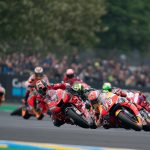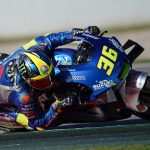Jonathan Rea caused quite a stir at Jerez last week, where the cream of World Superbike were sharing a track with some of the MotoGP teams, at a test hosted by Ducati. On Thursday, when the weather and track conditions were at their best, Rea hustled his WorldSBK spec Kawasaki ZX-10R around the Spanish circuit nearly a quarter of a second faster than Alvaro Bautista lapped on a Ducati Desmosedici GP16 MotoGP machine. He also put in two race simulations, one of which was just shy of the pace of Valentino Rossi during the MotoGP pace at Jerez in May of this year. Once again, the question was raised why Jonathan Rea wasn’t in MotoGP.
It is a good question…with several different answers, some simple, some not quite so simple. Rea, along with his main rival for 2017 Chaz Davies, are clearly the best of the WorldSBK field. They have all of the traits a rider needs to be world champion: sheer talent, the ability to override a bike and get more out of it than others, regularly beating their teammates, the ability to escape and grind out an unbeatable pace, and the willingness to mix it up and take risks when they can’t get away. Above all, the will to win, and the desire to do whatever it takes to achieve that.
And yet team managers in MotoGP keep overlooking Rea, Davies, and just about everyone in the World Superbike paddock. Rea and Davies are too old they say. They have not had enough time on a MotoGP bike they say. Making the transition from World Superbikes to MotoGP is too hard they say, with new tyres to learn, new circuits, carbon brakes.
The real problem is that MotoGP team managers are incredibly conservative and risk averse. Instead of trusting their instincts and their research, they look in the same places that every other team manager in the MotoGP paddock is looking: first to Moto2, then at Moto3, and then at the feeder series through the FIM CEV Junior World Championship. In search of the Next Big Thing, they look at the Current Big Thing, and try to find a junior version of that.
Right now, the Current Big Thing is a 23-year-old Spanish prodigy who came up through 125s and Moto2. There is no doubting Marc Márquez’ ability: five Grand Prix titles in nine seasons, and three MotoGP titles in four years is proof that he is a very special talent. So team managers are scouring Moto3, talking to the crop of talented youngsters currently filling the grids of that class, and making it so very entertaining to watch. If they have a Moto2 team, they are trying to convince those youngsters to ride for them in the intermediate class, dangling the carrot of a MotoGP contract to tempt them.
But is this really the best approach to finding new talent? It is certainly risky. Of the last 20 champions in the junior class, either 125cc or Moto3, only eight have even made it to MotoGP. Of those eight, only five have won a MotoGP race. Their names should be familiar: Valentino Rossi, Dani Pedrosa, Andrea Dovizioso, Marc Márquez, Maverick Viñales. Most of the rest were left stranded in 250s or Moto2. Some never even made it to the intermediate class. Of the five champions between 2011 and 2015, only Viñales has made a success of Moto2 and MotoGP. Danny Kent and Sandro Cortese have struggled in Moto2, Alex Márquez has taken nearly two seasons to start showing signs of promise. Nico Terol left Moto2 to go to World Superbikes, then World Supersport, and has been concentrating more on the Spanish Flat Track championship in the latter half of 2016 than he has on road racing.
Will the four rookies entering MotoGP in 2017 fare much better? Of the four – Jonas Folger and Johann Zarco at Monster Tech 3 Yamaha, Alex Rins at Suzuki, and Sam Lowes at Aprilia – it is Rins who is in the classic mould of young talent coming up fast. The Spaniard will be 21 by the time the season starts, and followed the traditional route. He was outstanding in the Spanish CEV championship, fought Viñales and Alex Márquez down to the wire for the Moto3 title, and took 10 attempts to win his first Moto2 race. His MotoGP debut got off to a rough start, crashing heavily at the Valencia test and fracturing two vertebrae. Nor were his early laps on the Suzuki GSX-RR much to write home about. He ended the first day as 21st fastest, nearly 1.9 seconds off the pace of the fastest rider, Maverick Viñales. By comparison, Marc Márquez was just a second slower than his teammate Dani Pedrosa when he first rode a MotoGP bike at Valencia, despite poor weather and a lack of time on the bike.
The two Tech 3 riders did a little better. Zarco and Folger finished around a second behind Viñales, and within a tenth of each other. Folger was the quicker of the two in 10th, Zarco just behind in 11th. Neither Folger nor Zarco fit the pattern of a traditional rookie. Folger is 23, and has been notably inconsistent throughout his career. He has won races in Moto2, but he has also finished anonymously in mid pack. Johann Zarco is 26, and took a long time to find his feet. He had one good year in 125s, then three mediocre years in Moto2, before finally breaking through and becoming the first ever rider to successfully defend a Moto2 title. Zarco is calm, introverted, deadly serious, utterly methodical.
Sam Lowes had the worst start of the lot. The 26-year-old Englishman was the slowest of the MotoGP regulars on the first day of the test, then crashed his Aprilia RS-GP early on the second day, bruising his neck and banging himself up fairly badly. At the test in Jerez last week, he only did a very few laps, and was clearly still struggling with injury. Lowes took the least conventional route of all the MotoGP rookies, having started in BSS/BSB, won a world championship in World Supersport, then moved over to Moto2.
Of the four MotoGP rookies, it is Zarco who looks the most promising. He was quickly up to speed, but what impressed most was the way that he worked: methodically, with attention to detail, working on one thing at a time. Tech 3 team boss Hervé Poncharal may have had some concerns over his rider signings in September, when both Folger and Zarco were struggling, but the test will have removed such doubts.
What if Zarco succeeds, and starts contending for podiums late in his first season, or from the start of his second season? That might be the only way we get to see some change in the approach of team managers. If a rider like Zarco starts to blossom in his late twenties, and become a genuine threat, managers may be forced to re-examine their beliefs. If the Next Big Thing takes their time to fulfil their potential, doors to older riders may start to open again. There may yet be hope for Jonathan Rea and Chaz Davies.
Photo by Kawasaki/Graeme Brown








